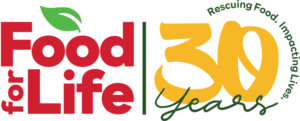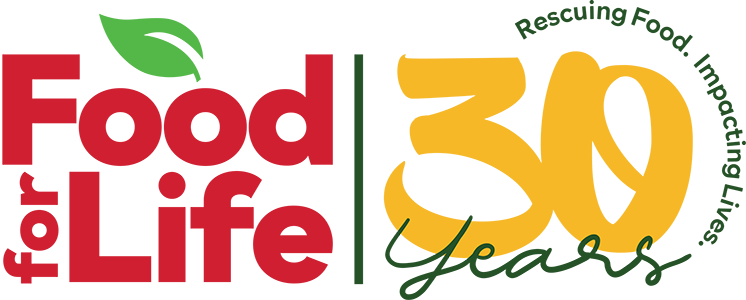Every day, I am inspired by people who reach out and ask questions about the work we do around food rescue. For some, it is a new concept. For others, it is a personal mission to not let this valuable resource go to waste.
This is what inspired us to launch FOOD for GOOD week. A week-long celebration that educates and inspires people to learn more and take action on an issue that is so simple to get involved with.
Inflation, precarious work, lack of affordable housing are just some of the reasons people access food support programs. While sharing food is not “the” answer to solve these challenges, it is simply common sense. If there is a tool that is not being used, but is available, let’s use it!
Billions of dollars of good surplus food are wasted each year and food production is a major contributor to our climate crisis. This is why Food for Life exists. We rescue, or recover, this GOOD surplus food from all levels of the supply chain. With a strong focus on healthy, perishable food, we then share it with people through a unique distribution system and network of partners.
Starting with a single loaf of bread in 1995, we now rescue close to five million pounds of GOOD surplus food each year in just Halton and Hamilton.
A recent report shared that across Canada found that just 4% of available surplus food is being rescued and put to its intended purpose … feeding people. We have more to do, and we need more people to make it happen.
GOOD rescued food has tremendous power to change lives as an economic and health support for individuals who struggle with income or access to healthy food for other reasons such as mobility.
In fact, this past year, we had an economic impact of more than 15 million dollars and diverted inedible food from landfill through our onsite compost program saving millions of kilograms of greenhouse gas emissions.
GOOD for people and the planet is just common sense.
What exactly is GOOD rescued food
Also known as recovered, reclaimed, or surplus food, rescued food is safe, edible food that otherwise would go to waste if it wasn’t saved — by people and organizations like ours — through a process called “food rescue.” Food rescue diverts food to friends and neighbours who face barriers to food access, including poverty and isolation.
In many cases, people facing food insecurity don’t go hungry because there isn’t enough food. They are food insecure because enough systems aren’t in place to connect people and food. That’s where Food for Life comes in!
So where does rescued food come from?
We get asked that question a lot! Rescued food is often surplus perishable food that is still good to eat but might be unwanted. It can include vegetables, fruit, meat, and dairy. Surplus food exists for many reasons. For example, overproduction causes surplus food. This is when a food producer or farm yields more food than expected or needed.
Surplus food also exists because of food imperfections. Even the most environmentally conscious consumer is guilty of choosing unbruised apples or bananas that haven’t started spotting. However, these, and many other foods are still perfectly healthy and delicious to eat, despite their flaws. Certain cuts of meat might also be discarded because they’re less desired than a sirloin or breast.
Food for Life also rescues food with packaging that has been damaged during the manufacturing, transportation, or storing processes. A few dents and bumps don’t affect the food inside a package; however, they often deem a product less desirable on a grocery store shelf.
Best before does not mean bad after. This misconception is another key reason there is so much food waste. Using a handy chart, you can see there are so many foods that are GOOD well beyond their best before date, yet marketing and our culture have told us to move on from those and pick the ones with the best dates. This food comes from all levels of the supply chain for us to access.
How does Food for Life get rescued food?
Last year, Food for Life rescued more than 4 million pounds of food! We collect surplus food from wholesalers, restaurants, grocery stores, and farms, among others. Approximately 800 volunteers mobilize this mission!
In recent years, Food for Life has strengthened our relationship with the local agricultural community, partnering with farmers who wanted to reduce food waste, but didn’t know how. Food for Life helps farmers be part of the solution, providing equitable food access to Halton’s growing and changing population.
Food for Life is also proud of our many community partnerships. By collaborating with other social service agencies in every city we serve, we’re able to provide a fresh food option to clients accessing services in many sectors, including affordable housing and youth recreation programs.
Moving food swiftly and safely isn’t possible without a reliable transportation fleet, which includes refrigerated vans, a hybrid diesel/electric truck, and a three-axel tandem truck. Click here to meet our fleet!
Using GOOD Rescued FOOD as a tool for change…
Food for Life is always championing new ways to use rescued food to help change the life situation for people, a great example is our new Mountainside Market.
Recently, our Mountainside Market opened at our Burlington warehouse, providing 100% GOOD rescued food. Open several days a week, it increases access to healthy food for neighbours in Halton region. It also provides them with a shopping experience that ensures dignity that isn’t always present at other food programs. This program allows us to rescue and share food items that may be more challenging to send into community or place in a GOOD food fridge in a local library, meaning less food going to landfill and more where it is supposed to be … on peoples plates.
Inspired? Join us on the Journey of GOOD by donating, volunteering or sign up to learn more.
GOOD food BUILDS community.

